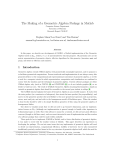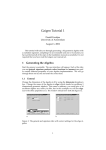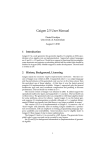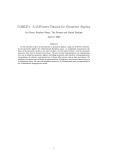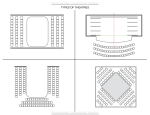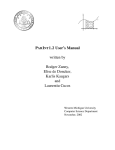Download libcga Reference Manual
Transcript
libcga Reference Manual
Generated by Doxygen 1.3.7
Mon Sep 20 13:48:51 2004
Contents
1 Libcga Documentation
1
2 libcga Module Index
3
2.1
libcga Modules . . . . . . . . . . . . . . . . . . . . . . . . . . . . . . . . . . . . . .
3 libcga Data Structure Index
3.1
libcga Data Structures . . . . . . . . . . . . . . . . . . . . . . . . . . . . . . . . . .
4 libcga File Index
4.1
libcga File List . . . . . . . . . . . . . . . . . . . . . . . . . . . . . . . . . . . . . .
5 libcga Page Index
5.1
libcga Related Pages . . . . . . . . . . . . . . . . . . . . . . . . . . . . . . . . . . .
6 libcga Module Documentation
3
5
5
7
7
9
9
11
6.1
Core multivector manipulation functions . . . . . . . . . . . . . . . . . . . . . . . .
11
6.2
Rotor interpolation functions for CGA . . . . . . . . . . . . . . . . . . . . . . . . .
18
6.3
Standard functions for CGA . . . . . . . . . . . . . . . . . . . . . . . . . . . . . . .
20
7 libcga Data Structure Documentation
23
7.1
multiv_s Struct Reference . . . . . . . . . . . . . . . . . . . . . . . . . . . . . . . .
23
7.2
plugin_s Struct Reference . . . . . . . . . . . . . . . . . . . . . . . . . . . . . . . .
25
8 libcga File Documentation
27
8.1
cga.h File Reference . . . . . . . . . . . . . . . . . . . . . . . . . . . . . . . . . . .
27
8.2
cga_rotor_interpolate.h File Reference . . . . . . . . . . . . . . . . . . . . . . . .
29
8.3
cga_stdfunc.h File Reference . . . . . . . . . . . . . . . . . . . . . . . . . . . . . .
30
9 libcga Page Documentation
31
9.1
Examples of Libcga Use . . . . . . . . . . . . . . . . . . . . . . . . . . . . . . . . .
31
9.2
A Simple Example . . . . . . . . . . . . . . . . . . . . . . . . . . . . . . . . . . . .
32
ii
CONTENTS
9.3
Introduction to Geometric Algebra . . . . . . . . . . . . . . . . . . . . . . . . . . .
34
9.4
Grade Tracking . . . . . . . . . . . . . . . . . . . . . . . . . . . . . . . . . . . . . .
39
Generated on Mon Sep 20 13:48:52 2004 for libcga by Doxygen
Chapter 1
Libcga Documentation
Introduction
libcga is a C library designed to allow ecient implementation of algorithms which use Geometric
Algebra(p. 34). The library has the following features:
1. It uses a modular, plugin-based approach to dierent algebras. This enables both extension
of the library to new algebras and optimisations in existing algebras to be introduced without
re-compiling programs which use the library. Also 3rd party algebra implementations may
be included.
2. The default algebra implementations utilise the
provide fast, ecient product calculation.
Grade Tracking(p. 39)
optimisation to
3. Various visualisation routines are provided to allow rapid display of results in a variety of
algebras and geometries (currently 3D Euclidean, 2D Hyperbolic and 3D Hyperbolic).
libcga is developed under Linux, but is designed to be portable. As a result, it runs on most other
Unix avors as well. Furthermore, compilation under Cygwin is possible on Windows systems.
This manual is divided into two parts, each of which is divided into several sections.
The rst part forms a user manual:
Introduction to Geometric Algebra(p. 34) provides a brief overview of the concepts in
Examples of Libcga Use(p. 31) provides some simple examples of using libcga.
Geometric Algebra.
The second part forms a reference manual:
Core multivector manipulation functions(p. 11) describes the core multivector manip-
ulation routines.
Standard functions for CGA(p. 20) describes some standard functions for working with
Rotor interpolation functions for CGA(p. 18) describes some functions useful for in-
multivectors
terpolating rotors.
drawing describes the functions available for visualising operations and multivectors in 3D
Euclidean CGA.
2
Libcga Documentation
drawing_2dh describes the functions available for visualising operations and multivectors in
2D Hyperbolic CGA.
drawing_3dh describes the functions available for visualising operations and multivectors in
3D Hyperbolic CGA.
libcga license
Copyright ©2001-2003 by Richard Wareham. Portions of the test programs Copyright ©1999
Paul Rademacher.
Permission to use, copy, modify, and distribute this software and its documentation under the
terms of the GNU General Public License is hereby granted. No representations are made about
the suitability of this software for any purpose. It is provided "as is" without express or implied
warranty. See the GNU General Public License for more details.
Future work
Acknowledgements
Thanks go to:
Add acknowledgements
Generated on Mon Sep 20 13:48:52 2004 for libcga by Doxygen
Chapter 2
libcga Module Index
2.1
libcga Modules
Here is a list of all modules:
Core multivector manipulation functions . . . . . . . . . . . . . . . . . . . . . . . . . . .
Rotor interpolation functions for CGA . . . . . . . . . . . . . . . . . . . . . . . . . . . .
Standard functions for CGA . . . . . . . . . . . . . . . . . . . . . . . . . . . . . . . . . .
11
18
20
4
libcga Module Index
Generated on Mon Sep 20 13:48:52 2004 for libcga by Doxygen
Chapter 3
libcga Data Structure Index
3.1
libcga Data Structures
Here are the data structures with brief descriptions:
multiv_s
plugin_s
. . . . . . . . . . . . . . . . . . . . . . . . . . . . . . . . . . . . . . . . . . .
. . . . . . . . . . . . . . . . . . . . . . . . . . . . . . . . . . . . . . . . . . .
23
25
6
libcga Data Structure Index
Generated on Mon Sep 20 13:48:52 2004 for libcga by Doxygen
Chapter 4
libcga File Index
4.1
libcga File List
Here is a list of all documented les with brief descriptions:
cga.h . . . . . . . . . . . . .
cga_internal.h . . . . . . .
cga_rotor_interpolate.h
cga_stdfunc.h . . . . . . .
.
.
.
.
.
.
.
.
.
.
.
.
.
.
.
.
.
.
.
.
.
.
.
.
.
.
.
.
.
.
.
.
.
.
.
.
.
.
.
.
.
.
.
.
.
.
.
.
.
.
.
.
.
.
.
.
.
.
.
.
.
.
.
.
.
.
.
.
.
.
.
.
.
.
.
.
.
.
.
.
.
.
.
.
.
.
.
.
.
.
.
.
.
.
.
.
.
.
.
.
.
.
.
.
.
.
.
.
.
.
.
.
.
.
.
.
.
.
.
.
.
.
.
.
.
.
.
.
.
.
.
.
27
??
29
30
8
libcga File Index
Generated on Mon Sep 20 13:48:52 2004 for libcga by Doxygen
Chapter 5
libcga Page Index
5.1
libcga Related Pages
Here is a list of all related documentation pages:
Examples of Libcga Use .
A Simple Example . . . .
Introduction to Geometric
Grade Tracking . . . . . .
. . . . .
. . . . .
Algebra
. . . . .
.
.
.
.
.
.
.
.
.
.
.
.
.
.
.
.
.
.
.
.
.
.
.
.
.
.
.
.
.
.
.
.
.
.
.
.
.
.
.
.
.
.
.
.
.
.
.
.
.
.
.
.
.
.
.
.
.
.
.
.
.
.
.
.
.
.
.
.
.
.
.
.
.
.
.
.
.
.
.
.
.
.
.
.
.
.
.
.
.
.
.
.
.
.
.
.
.
.
.
.
.
.
.
.
.
.
.
.
.
.
.
.
.
.
.
.
.
.
.
.
31
32
34
39
10
libcga Page Index
Generated on Mon Sep 20 13:48:52 2004 for libcga by Doxygen
Chapter 6
libcga Module Documentation
6.1
Core multivector manipulation functions
Data Structures
struct
multiv_s
Denes
#dene
#dene
CGA_TYPE oat
CGA_OPT_GRADETRACKING 0x001
Typedefs
typedef
multiv_s ∗ multiv_t
Functions
CGA_SCOPE
CGA_SCOPE
CGA_SCOPE
CGA_SCOPE
CGA_SCOPE
CGA_SCOPE
CGA_SCOPE
CGA_SCOPE
CGA_SCOPE
CGA_SCOPE
CGA_SCOPE
CGA_SCOPE
CGA_SCOPE
CGA_SCOPE
CGA_SCOPE
CGA_SCOPE
int cga_init ()
void cga_nalise ()
int cga_load_algebra (char ∗name)
multiv_t cga_new_multiv ()
void cga_free_multiv (multiv_t mv)
multiv_t cga_stdmv (const char ∗specier)
CGA_TYPE ∗ cga_get_element (multiv_t mv, int grade, int id)
void cga_dump (multiv_t mv)
void cga_reverse (multiv_t src, multiv_t dest)
void cga_add (multiv_t a, multiv_t b, multiv_t c)
void cga_subtract (multiv_t a, multiv_t b, multiv_t c)
void cga_outer (multiv_t a, multiv_t b, multiv_t c)
void cga_inner (multiv_t a, multiv_t b, multiv_t c)
void cga_geometric (multiv_t a, multiv_t b, multiv_t c)
void cga_meet (multiv_t a, multiv_t b, multiv_t c)
void cga_cpy (multiv_t to, multiv_t from)
12
libcga Module Documentation
CGA_SCOPE
CGA_SCOPE
CGA_SCOPE
CGA_SCOPE
CGA_SCOPE
CGA_SCOPE
CGA_SCOPE
CGA_SCOPE
CGA_SCOPE
CGA_SCOPE
void cga_extract_grade (int n, multiv_t a, multiv_t b)
int cga_factorise_bivector (multiv_t mv, multiv_t a, multiv_t b)
CGA_TYPE cga_mag2 (multiv_t a)
void cga_dual (multiv_t a, multiv_t b)
void cga_scale (CGA_TYPE beta, multiv_t mv)
void cga_reset_ops ()
unsigned long cga_ops ()
void cga_set_optimisations (int opt_ags)
int cga_optimisation_ags ()
void cga_make_zero (multiv_t mv)
6.1.1 Detailed Description
These are the functions that nearly all programs using libcga will need to use. They provide the
basic products and multivector manipulations that you will need. All other parts of the library
use these functions.
6.1.2 Dene Documentation
6.1.2.1 #dene CGA_TYPE oat
The type used to represent multivector components, etc.
6.1.3 Typedef Documentation
6.1.3.1 typedef multiv_s∗ multiv_t
A pointer to a
multiv_s(p. 23) structure.
See also:
The multiv_s(p. 23) structure.
6.1.4 Function Documentation
6.1.4.1 CGA_SCOPE int cga_init ()
Initialise the CGA library and load the default plugin ('5dcga').
Returns:
0 if there was an error starting, non-zero otherwise.
See also:
cga_nalise()(p. 14), cga_load_algebra()(p. 14)
6.1.4.2 CGA_SCOPE void cga_nalise ()
Finalise the CGA library (unloading any loaded plugins).
See also:
cga_init()(p. 14)
Generated on Mon Sep 20 13:48:52 2004 for libcga by Doxygen
6.1 Core multivector manipulation functions
13
6.1.4.3 CGA_SCOPE int cga_load_algebra (char ∗ name)
Loads a particular algebra by name. Currently the following plugins are included by default:
3dcga Conformal extension of 3D Euclidean space, signature is (4,1)
2dcga Conformal extension of 2D Euclidean space, signature is (3,1)
3ddesit Conformal extension of 3D deSitter space, signature is ++-+2ddesit Conformal extension of 2D deSitter space, signature is +-+5d 5D Euclidean space, signature (5,0)
4d 4D Euclidean space, signature (4,0)
3d 3D Euclidean space, signature (3,0)
5d 5D Euclidean space, signature (5,0)
Returns:
0 on failure, non-zero on success
6.1.4.4 CGA_SCOPE multiv_t cga_new_multiv ()
Creates a multivector and initialises it to zero.
Returns:
A pointer to the new multivector which must be freed with
NULL on error.
cga_free_multiv()(p. 15) or
See also:
cga_free_multiv()(p. 15)
6.1.4.5 CGA_SCOPE void cga_free_multiv (multiv_t mv)
Frees the resources associated with a multivector previously initialised by
multiv()(p. 14)
cga_new_-
Parameters:
mv The multivector whose resources should be freed.
See also:
cga_new_multiv()(p. 14)
6.1.4.6 CGA_SCOPE multiv_t cga_stdmv (const char ∗ specier)
Creates and returns a 'standard' multivector. For example, 'e0' gives the unit scalar, 'e12' gives
e1 ∧ e2 and 'I' gives the pseudoscalar.
Parameters:
specier
The name of the standard multivector to return.
Returns:
The created multivector. This must be freed with
no-longer needed.
Generated on Mon Sep 20 13:48:52 2004 for libcga by Doxygen
cga_free_multiv()(p. 15)
when it is
14
libcga Module Documentation
6.1.4.7 CGA_SCOPE CGA_TYPE∗ cga_get_element (multiv_t mv, int grade,
int id)
Get a pointer to the component with specied grade and id. For example the e124 component has
grade 3, id 124.
Returns:
A pointer to the specied component or NULL if the component grade/id was invalid.
6.1.4.8 CGA_SCOPE void cga_dump (multiv_t mv)
Dumps the contents of a multivector to stdout.
Parameters:
mv The multivector to dump.
6.1.4.9 CGA_SCOPE void cga_reverse (multiv_t src, multiv_t dest)
Find the reverse of a multivector.
Parameters:
src The multivector to nd the reverse of.
dest The multivector to write the result into.
6.1.4.10 CGA_SCOPE void cga_add (multiv_t a, multiv_t b, multiv_t c)
Adds two multivectors together.
Parameters:
a The rst multivector.
b The second multivector.
c The multivector that the result of a + b is written into.
6.1.4.11 CGA_SCOPE void cga_subtract (multiv_t a, multiv_t b, multiv_t c)
Subtracts one multivector from another.
Parameters:
a The rst multivector.
b The second multivector.
c The multivector that the result of a − b is written into.
Generated on Mon Sep 20 13:48:52 2004 for libcga by Doxygen
6.1 Core multivector manipulation functions
15
6.1.4.12 CGA_SCOPE void cga_outer (multiv_t a, multiv_t b, multiv_t c)
Find the outer (aka 'wedge') product of two multivectors.
Parameters:
a The rst multivector.
b The second multivector.
c The multivector that the result of a ∧ b is written into.
6.1.4.13 CGA_SCOPE void cga_inner (multiv_t a, multiv_t b, multiv_t c)
Find the inner (aka 'dot') product of two multivectors.
Parameters:
a The rst multivector.
b The second multivector.
c The multivector that the result of a · b is written into.
6.1.4.14 CGA_SCOPE void cga_geometric (multiv_t a, multiv_t b, multiv_t c)
Find the geometric (aka 'Cliord') product of two multivectors.
Parameters:
a The rst multivector.
b The second multivector.
c The multivector that the result of ab is written into.
6.1.4.15 CGA_SCOPE void cga_meet (multiv_t a, multiv_t b, multiv_t c)
Find the meet of two multivectors.
Parameters:
a The rst multivector.
b The second multivector.
c The multivector that the result of a ∨ b is written into.
6.1.4.16 CGA_SCOPE void cga_cpy (multiv_t to, multiv_t from)
Copies one multivector inot another.
Parameters:
to The multivector to copy into.
from The multivector to copt from.
Generated on Mon Sep 20 13:48:52 2004 for libcga by Doxygen
16
libcga Module Documentation
6.1.4.17 CGA_SCOPE void cga_extract_grade (int n, multiv_t a, multiv_t b)
Sets all but grade 'n' elements to zero.
Parameters:
n The grade to preserve.
a The source multivector.
b The multivector to write the result into.
6.1.4.18 CGA_SCOPE int cga_factorise_bivector (multiv_t mv, multiv_t a,
multiv_t b)
Factorises a bivector A ∧ B into two null-vectors A and B .
Parameters:
mv The multivector to factorise.
a One multivector to write the result into.
b The other multivector to write the result into.
Returns:
0 if this cannot be done, non-zero otherwise.
6.1.4.19 CGA_SCOPE CGA_TYPE cga_mag2 (multiv_t a)
Returns the magnitude SQUARED of the multivector, i.e. returns a2
6.1.4.20 CGA_SCOPE void cga_dual (multiv_t a, multiv_t b)
Sets b to the dual of a.
6.1.4.21 CGA_SCOPE void cga_scale (CGA_TYPE beta, multiv_t mv)
Scales mv by a scalar beta.
6.1.4.22 CGA_SCOPE void cga_reset_ops ()
Resets the global FLOP count to zero
6.1.4.23 CGA_SCOPE unsigned long cga_ops ()
Returns the global FLOP count
6.1.4.24 CGA_SCOPE void cga_set_optimisations (int opt_ags)
Sets the optimisation ags.
Note:
This is mainly intended for debugging and benchmarking the library.
Generated on Mon Sep 20 13:48:52 2004 for libcga by Doxygen
6.1 Core multivector manipulation functions
6.1.4.25 CGA_SCOPE int cga_optimisation_ags ()
Gets the optimisation ags
Note:
This is mainly intended for debugging and benchmarking the library.
6.1.4.26 CGA_SCOPE void cga_make_zero (multiv_t mv)
Sets all components and the grade mask of the passed multivector to zero.
Parameters:
mv The multivector to set to zero.
Generated on Mon Sep 20 13:48:52 2004 for libcga by Doxygen
17
18
libcga Module Documentation
6.2
Rotor interpolation functions for CGA
Functions
CGA_SCOPE
∗angle)
CGA_SCOPE
CGA_SCOPE
CGA_SCOPE
CGA_SCOPE
void
void
void
void
void
cga_matrix_to_action
(oat ∗matrix,
multiv_t
plane, oat
cga_matrix_to_rotor (oat ∗m, multiv_t rotor)
cga_rotor_to_matrix (multiv_t rotor, oat ∗m)
cga_rotor_log (multiv_t rotor, multiv_t log)
cga_rotor_exp (multiv_t log, multiv_t rotor)
6.2.1 Detailed Description
These functions implement the method of rotor interpolation by logarithm-like functions.
6.2.2 Function Documentation
6.2.2.1 CGA_SCOPE void cga_matrix_to_action (oat
plane, oat ∗ angle)
∗
matrix, multiv_t
This function is still buggy!
Converts a 4x4 rotation matrix into the corresponding rotation plane (expressed as a bivector
parallel to it) and the angle of rotation within the plane. The matrix is passed as an array of
oats as in glMultMatrix(3) and friends. The elements of the array m are arranged in the matrix
thus
m[0] m[4] m[8] m[12]
m[1] m[5] m[9] m[13]
m[2] m[6] m[10] m[14]
m[3] m[7] m[11] m[15]
Parameters:
matrix The matrix to convert into a rotor.
plane The multiv_t which gets written with the plane.
angle Pointer to a oat to write the angle into.
See also:
cga_rotor_to_matrix()(p. ??)
6.2.2.2 CGA_SCOPE void cga_matrix_to_rotor (oat ∗ m, multiv_t rotor)
This function is still buggy!
Converts a 4x4 rotation matrix into the corresponding rotor (assuming we are using the 3dcga
algebra). The matrix is passed as an array of oats as in glMultMatrix(3) and friends. The
elements of the array m are arranged in the matrix thus
m[0] m[4] m[8] m[12]
m[1] m[5] m[9] m[13]
m[2] m[6] m[10] m[14]
m[3] m[7] m[11] m[15]
Generated on Mon Sep 20 13:48:52 2004 for libcga by Doxygen
6.2 Rotor interpolation functions for CGA
Parameters:
m The matrix to convert into a rotor.
rotor The multiv_t which gets written with the rotor.
See also:
cga_rotor_to_matrix()(p. ??)
6.2.2.3 CGA_SCOPE void cga_rotor_to_matrix (multiv_t rotor, oat ∗ m)
Like
cga_matrix_to_rotor()(p. ??) but works in reverse.
Parameters:
rotor The rotor to convert into a 4x4 matrix.
m The array containing the matrix elements to write into.
See also:
cga_matrix_to_rotor()(p. ??)
6.2.2.4 CGA_SCOPE void cga_rotor_log (multiv_t rotor, multiv_t log)
Takes the pseudo-logarithm of the rotor passed.
Parameters:
rotor The rotor to work on.
log The multiv_t to write the log into.
See also:
cga_rotor_exp()(p. ??)
6.2.2.5 CGA_SCOPE void cga_rotor_exp (multiv_t log, multiv_t rotor)
The reverse of
cga_rotor_log()(p. ??), forms the original rotor from the pseudo-logarithm.
Parameters:
log The pseudo-logarithm of the rotor.
rotor The multiv_t to write the reultant rotor into.
See also:
cga_rotor_log()(p. ??)
Generated on Mon Sep 20 13:48:52 2004 for libcga by Doxygen
19
20
libcga Module Documentation
6.3
Standard functions for CGA
Denes
#dene
cga_assign_vector(mv, components, num_components)
Functions
CGA_SCOPE
CGA_SCOPE
CGA_SCOPE
CGA_SCOPE
CGA_SCOPE
CGA_SCOPE
CGA_SCOPE
CGA_SCOPE
CGA_SCOPE
CGA_SCOPE
void
void
void
void
void
void
void
void
void
void
cga_map (multiv_t x)
cga_imap (multiv_t x)
cga_maph (multiv_t x)
cga_imaph (multiv_t x)
cga_rotor (CGA_TYPE rad, multiv_t plane, multiv_t rot)
cga_translator (multiv_t x, multiv_t T)
cga_dilator (CGA_TYPE rho, multiv_t D)
cga_rotorh (CGA_TYPE rad, multiv_t plane, multiv_t rot)
cga_translatorh (multiv_t x, multiv_t T)
cga_sphere (multiv_t C, CGA_TYPE radius, multiv_t sigma)
6.3.1 Detailed Description
These functions implement the various n -d vector to (n +2)-d null-vector mappings that can be
performed along with appropriate functions to calculate rotors.
6.3.2 Dene Documentation
6.3.2.1 #dene cga_assign_vector(mv, components, num_components)
Value:
cga_make_zero(mv); mv->grade_mask |= (1 << 1); \
memcpy(cga_get_element(mv, 1, 1), components, num_components * sizeof(CGA_TYPE))
Assigns a multivector the vector with components passed. This is implemented as a macro and is
designed as a 'quick-and-dirty' way of doing what should really be done properly.
Parameters:
mv The multivector to assign the vector to.
components An array of components.
num_components The number of components.
Note that the behaviour when trying to
assign more components than the multivector can take is un-dened.
6.3.3 Function Documentation
6.3.3.1 CGA_SCOPE void cga_map (multiv_t x)
Map the Euclidean point x into a null-vector using the Euclidean mapping x 7→
with λ = 1.
1
2
2
2λ (x n+2λx−λ n̄)
Generated on Mon Sep 20 13:48:52 2004 for libcga by Doxygen
6.3 Standard functions for CGA
21
Parameters:
x The vector to be mapped.
This vector is directly modied so that after the function call it
contains the mapped null-vector.
6.3.3.2 CGA_SCOPE void cga_imap (multiv_t x)
Map the null-vector x into a point using the inverse of the Euclidean mapping x 7→
2λx − λ2 n̄) with λ = 1.
1
2
2λ (x n
+
Parameters:
x The null-vector
to be inverse-mapped. This vector is directly modied so that after the
function call it contains the original point.
6.3.3.3 CGA_SCOPE void cga_maph (multiv_t x)
Map the Euclidean point x which must be within the unit-disc into a null-vector using the non1
2
2
Euclidean (hyperbolic) mapping x 7→ λ2 −x
2 (x n + 2λx − λ n̄) with λ = 1.
Parameters:
x The vector to be mapped.
This vector is directly modied so that after the function call it
contains the mapped null-vector.
6.3.3.4 CGA_SCOPE void cga_imaph (multiv_t x)
Map the null-vector x into a point within the unit-circle using the inverse of the non-Euclidean
1
2
2
(hyperbolic) mapping x 7→ λ2 −x
2 (x n + 2λx − λ n̄) with λ = 1.
Parameters:
x The null-vector
to be inverse-mapped. This vector is directly modied so that after the
function call it contains the original point.
6.3.3.5 CGA_SCOPE void cga_rotor (CGA_TYPE rad, multiv_t plane,
multiv_t rot)
Form a Euclidean rotation rotor. The rotor will rotate in a specied plane by a specied amount.
Parameters:
rad The angle, in radians, to rotate by.
plane The plane to rotate in (e.g. e12 to rotate in plane spanned by e1 and e2 ).
rot This multivector will be over-written with the rotor.
6.3.3.6 CGA_SCOPE void cga_translator (multiv_t x, multiv_t T)
Form a Euclidean translation rotor.
Parameters:
x The (Euclidean) point that the translator should map the origin to.
T This multivector will be over-written with the rotor.
Generated on Mon Sep 20 13:48:52 2004 for libcga by Doxygen
22
libcga Module Documentation
6.3.3.7 CGA_SCOPE void cga_dilator (CGA_TYPE rho, multiv_t D)
Form a Euclidean dilator rotor. FIXME: This function is not yet generalised beyond the "3dcga"
algebra.
Parameters:
rho The dilation factor factor.
D This multivector will be over-written with the rotor.
6.3.3.8 CGA_SCOPE void cga_rotorh (CGA_TYPE rad, multiv_t plane,
multiv_t rot)
Form a hyperbolic rotation rotor. The rotor will rotate in a specied plane by a specied amount.
Parameters:
rad The angle, in radians, to rotate by.
plane The plane to rotate in (e.g. e12 to rotate in plane spanned by e1 and e2 ).
rot This multivector will be over-written with the rotor.
6.3.3.9 CGA_SCOPE void cga_translatorh (multiv_t x, multiv_t T)
Form a hyperbolic translation rotor.
Parameters:
x The (Euclidean) point within the unit-circle that the translator should map the origin to.
T This multivector will be over-written with the rotor.
6.3.3.10 CGA_SCOPE void cga_sphere (multiv_t C, CGA_TYPE radius,
multiv_t sigma)
Creates a multivector with a spherical INNER null-space, i.e. the dual of a sphere, with a given
centre and radius.
Parameters:
C The null-vector representation of the Euclidean point giving the centre.
radius The radius.
sigma This multivector will be overwritten with the sphere.
Generated on Mon Sep 20 13:48:52 2004 for libcga by Doxygen
Chapter 7
libcga Data Structure
Documentation
7.1
multiv_s Struct Reference
#include <cga.h>
Data Fields
uint32_t max_grade
uint32_t grade_mask
CGA_TYPE ∗ components
uint32_t num_components
unsigned char dimension
7.1.1 Detailed Description
The multiv_t type encapsulates a generic multivector. A multivector is specied in terms of a set
of components proportional to the basis elements {e1 , e2 , ..., e12 , e23 , ..., eijk... } and a 'grade-mask'
which shows which grades are present.
7.1.2 Field Documentation
7.1.2.1 uint32_t multiv_s::max_grade
Maximum grade of any element
7.1.2.2 uint32_t multiv_s::grade_mask
If bit 'n' set, multivector has component of grade 'n'
7.1.2.3 CGA_TYPE∗ multiv_s::components
A pointer to an num_components length array of components
24
libcga Data Structure Documentation
7.1.2.4 uint32_t multiv_s::num_components
Number of components
7.1.2.5 unsigned char multiv_s::dimension
Dimension of space
The documentation for this struct was generated from the following le:
cga.h
Generated on Mon Sep 20 13:48:52 2004 for libcga by Doxygen
7.2 plugin_s Struct Reference
7.2
plugin_s Struct Reference
#include <cga_internal.h>
Data Fields
cga_prod_f geometric_prod
cga_prod_f outer_prod
cga_prod_f hestenes_prod
cga_prod_f dot_prod
cga_prod_f scalar_prod
cga_reverse_f reverse
cga_project_f project_to_grade
cga_new_f new_mv
cga_element_accessor_f element_accessor
cga_stdmv_f stdmv
cga_dump_f dump
7.2.1 Detailed Description
Internal to libcga.
The documentation for this struct was generated from the following le:
cga_internal.h
Generated on Mon Sep 20 13:48:52 2004 for libcga by Doxygen
25
26
libcga Data Structure Documentation
Generated on Mon Sep 20 13:48:52 2004 for libcga by Doxygen
Chapter 8
libcga File Documentation
8.1
cga.h File Reference
Data Structures
struct
multiv_s
Denes
#dene
#dene
#dene
CGA_SCOPE extern
CGA_TYPE oat
CGA_OPT_GRADETRACKING 0x001
Typedefs
typedef unsigned int uint32_t
typedef multiv_s ∗ multiv_t
Functions
CGA_SCOPE
CGA_SCOPE
CGA_SCOPE
CGA_SCOPE
CGA_SCOPE
CGA_SCOPE
CGA_SCOPE
CGA_SCOPE
CGA_SCOPE
CGA_SCOPE
CGA_SCOPE
CGA_SCOPE
CGA_SCOPE
CGA_SCOPE
int cga_init ()
void cga_nalise ()
int cga_load_algebra (char ∗name)
multiv_t cga_new_multiv ()
void cga_free_multiv (multiv_t mv)
multiv_t cga_stdmv (const char ∗specier)
CGA_TYPE ∗ cga_get_element (multiv_t mv, int grade, int id)
void cga_dump (multiv_t mv)
void cga_reverse (multiv_t src, multiv_t dest)
void cga_add (multiv_t a, multiv_t b, multiv_t c)
void cga_subtract (multiv_t a, multiv_t b, multiv_t c)
void cga_outer (multiv_t a, multiv_t b, multiv_t c)
void cga_inner (multiv_t a, multiv_t b, multiv_t c)
void cga_geometric (multiv_t a, multiv_t b, multiv_t c)
28
libcga File Documentation
CGA_SCOPE
CGA_SCOPE
CGA_SCOPE
CGA_SCOPE
CGA_SCOPE
CGA_SCOPE
CGA_SCOPE
CGA_SCOPE
CGA_SCOPE
CGA_SCOPE
CGA_SCOPE
CGA_SCOPE
void cga_meet (multiv_t a, multiv_t b, multiv_t c)
void cga_cpy (multiv_t to, multiv_t from)
void cga_extract_grade (int n, multiv_t a, multiv_t b)
int cga_factorise_bivector (multiv_t mv, multiv_t a, multiv_t b)
CGA_TYPE cga_mag2 (multiv_t a)
void cga_dual (multiv_t a, multiv_t b)
void cga_scale (CGA_TYPE beta, multiv_t mv)
void cga_reset_ops ()
unsigned long cga_ops ()
void cga_set_optimisations (int opt_ags)
int cga_optimisation_ags ()
void cga_make_zero (multiv_t mv)
8.1.1 Detailed Description
Core multivector manipulation functions
Generated on Mon Sep 20 13:48:52 2004 for libcga by Doxygen
8.2 cga_rotor_interpolate.h File Reference
8.2
29
cga_rotor_interpolate.h File Reference
Denes
#dene
CGA_SCOPE extern
Functions
CGA_SCOPE
∗angle)
CGA_SCOPE
CGA_SCOPE
CGA_SCOPE
CGA_SCOPE
void
void
void
void
void
cga_matrix_to_action
(oat ∗matrix,
multiv_t
cga_matrix_to_rotor (oat ∗m, multiv_t rotor)
cga_rotor_to_matrix (multiv_t rotor, oat ∗m)
cga_rotor_log (multiv_t rotor, multiv_t log)
cga_rotor_exp (multiv_t log, multiv_t rotor)
8.2.1 Detailed Description
Rotor interpolation functions for CGA
Generated on Mon Sep 20 13:48:52 2004 for libcga by Doxygen
plane, oat
30
libcga File Documentation
8.3
cga_stdfunc.h File Reference
#include <string.h>
Denes
#dene
#dene
CGA_SCOPE extern
cga_assign_vector(mv, components, num_components)
Functions
CGA_SCOPE
CGA_SCOPE
CGA_SCOPE
CGA_SCOPE
CGA_SCOPE
CGA_SCOPE
CGA_SCOPE
CGA_SCOPE
CGA_SCOPE
CGA_SCOPE
void
void
void
void
void
void
void
void
void
void
cga_map (multiv_t x)
cga_imap (multiv_t x)
cga_maph (multiv_t x)
cga_imaph (multiv_t x)
cga_rotor (CGA_TYPE rad, multiv_t plane, multiv_t rot)
cga_translator (multiv_t x, multiv_t T)
cga_dilator (CGA_TYPE rho, multiv_t D)
cga_rotorh (CGA_TYPE rad, multiv_t plane, multiv_t rot)
cga_translatorh (multiv_t x, multiv_t T)
cga_sphere (multiv_t C, CGA_TYPE radius, multiv_t sigma)
8.3.1 Detailed Description
Standard functions for CGA.
Generated on Mon Sep 20 13:48:52 2004 for libcga by Doxygen
Chapter 9
libcga Page Documentation
9.1
Examples of Libcga Use
The following sections contain simple example programs to illustrate features of libcga.
A Simple Example(p. 32) - How to initialise the library, create a multivector and compile
a program.
Back to
Libcga Documentation(p. ??)
32
9.2
libcga Page Documentation
A Simple Example
The program simpletest.c is shown below. It is a simple program to create a multivector, map
a 3D Euclidean vector and verifying that the result is a null-vector.
Libcga supports the pkg-config utility to provide the correct compiler and linker ags. To compile
and run the program, change to the directory containing the source le and run the command
$ gcc -o simpletest simpletest.c `pkg-config libcga --cflags --libs`
If you get errors about libcga.pc not being found in the pkg-config search path, make sure
the the directory containing the libcga.pc le installed with libcga is in the PKG_CONFIG_PATH
environment variable.
Lets walk-through simpletest.cc line-by-line to explore what it does.
Firstly you must #include the appropriate header les containing the libcga functions you intend
to use.
These pre-processor directives dene some convenience macros to create/destroy multivector objects and getting/setting individual components. You should always access components in this
way and never through the components(p. 23) eld of multiv_t. This is to protect against the
implementation changing in future releases of libcga.
Inside the main function we initialise the library. The call to cga_init()(p. 14) must be done
before any other call to libcga. We also attempt to load the appropriate algebra, gracefully
exiting if we fail for some reason (normally due to the correct plugin not being found).
We now create three multivector objects. Before you call cga_new_multiv()(p. 14) any
multiv_t variables are invalid. To avoid memory leaks you should always call cga_free_multiv()(p. 15) on any creates multiv_t objects.
Using our convenience macros we set the e1 , e2 and e3 components of a so that it corresponds to
the Euclidean vector (3, 4, 6).
cga_map We now use the cga_map()(p. 21) function to map a into the Conformal space. If
we were dealing with hyperbolic space we could use the cga_maph()(p. 21) function. Note that
these functions are dened in cga_stdfunc.h(p. 30) which is why we needed to #include that
le.
Generated on Mon Sep 20 13:48:52 2004 for libcga by Doxygen
9.2 A Simple Example
33
The cga_dump()(p. 15) function dumps the contents of a multiv_t to stdout. Its mainly useful
for debugging. At this point a should be a 5D vector.
The mapped vector should be a null-vector so we square a and dump the result to make sure it is
zero. Note that we square a and store the result in b to make sure we don't overwrite the value
of a.
Finally we inverse-map a and print the e1 , e2 and e3 components to verify that the inverse mapping
works correctly.
Now we are nished with the multivectors we must free the resources they used.
Now we have nished using libcga we can call
made after this call.
cga_nalise()(p. 14).
No calls to libcga should be
Back to
Examples of Libcga Use(p. 31), Libcga Documentation(p. ??)
Back to
Examples of Libcga Use(p. 31), Libcga Documentation(p. ??)
Generated on Mon Sep 20 13:48:52 2004 for libcga by Doxygen
34
9.3
libcga Page Documentation
Introduction to Geometric Algebra
9.3.1 Introduction
Since its inception in the mid-1970s, Computer Graphics (CG) has almost universally used linear
algebra as its mathematical framework. This may be due to two factors; most early practitioners
of computer graphics were mathematicians familiar with it and linear algebra provided a compact,
ecient way of representing points, transformations, lines, etc.
As computing power becomes cheaper, the opportunity arises to investigate new frameworks for
CG which, although not providing the time/space eciency of linear algebra, may provide a
conceptually simpler system or one of greater analytical power.
9.3.1.1 Brief overview of Geometric Algebra
We shall assume a basic familiarity with Cliord algebras and merely describe the mechanism
whereby they may be used to perform geometric operations.
We rst write down a basis which can generate all elements of the Cliord algebra with vector
elements in R2 through linear combination
{1, e1 , e2 , e1 e2 }
where e1 , e2 are the usual orthonormal Euclidean basis vectors and hence e1 e2 = e1 · e2 + e1 ∧ e2 =
e1 ∧ e2 . For convenience we shall denote ei ej as eij and, generally, ei ej . . . ek as eij...k . A general
linear sum of these components is termed a multivector whereas a sum of only grade-n components
is called a n-vector . This paper will use the convention of writing multivectors, bivectors, trivectors
and higher-grade elements in upper-case and vectors and scalars in lower-case.
Firstly, note that
(e1 e2 )2 = e1 e2 e1 e2 = −e1 e2 e2 e1 = −1
and thus we have an element of the algebra which squares
to −1. As shown by Hestenes (1999)
√
this can be identied with the unit imaginary i = −1 in C and, as such, the highest-grade
basis-element in a geometric algebra is often denoted I and referred to as the pseudoscalar .
Hestenes (1999) also showed that many of the identities and theorems dealing with complex numbers have a direct analogue in Cliord algebra and hence suggested a geometrical interpretation
he named Geometric Algebra .
To demonstrate the approach, consider three orthonormal basis vectors in R3 , {e1 , e2 , e3 }. We can
form 3 dierent bivectors from these vectors
B1 = e2 e3 ,
B2 = e3 e1 ,
B3 = e1 e2
Now consider the eect of B3 upon the vectors e1 and e1 + e2 :
e1 B3 = e1 e1 e2 = e21 e2 = e2
(e1 + e2 )B3 = e1 B3 + e2 B3 = e2 + e2 e1 e2 = e2 − e1 e22 = e2 − e1
latex rotation.eps
The rotation eect upon the vectors e1 and e1 + e2 produced by forming the Cliord
product with the bivector B3 = e1 e2 .
Generated on Mon Sep 20 13:48:52 2004 for libcga by Doxygen
9.3 Introduction to Geometric Algebra
35
It is clear that B3 has the eect of rotating the vectors by −π/2. It is, in fact, a general property
that the bivector ei ej will rotate a vector −π/2 in the plane dened by ei and ej . At rst glance
this seems to oer little more than complex numbers or quaternions but at no point have we
assumed that we are working in 3-dimensional space; this method also extends to higher spaces.
Now we consider general rotations. Firstly it is trivial to show that B3 squares to −1:
B32 = e1 e2 e1 e2 = −e1 e2 e2 e1 = −1
and we can represent any vector Z in the plane dened by e1 and e2 using
Z = r(e1 cos θ + e2 sin θ)
Z = e1 r(cos θ + B3 sin θ)
where r is the distance of the point Z from the origin and θ is the angle Z makes with e1 . Since
B32 = −1, by considering the power series expansion of the exponential function, it can be shown
that
eB3 θ = cos θ + B3 sin θ
which is analogous to de Moivre's theorem for complex numbers.
We can thus represent any vector x which lies in the plane of the bivector B3 by
x = e1 reB3 θ = re1 cos θ + re2 sin θ
Hence we can state that the rotation of a vector x which lies in the e1 e2 plane by φ radians is
accomplished by
x 7→ xeB3 φ = x(cos φ + B3 sin φ)
This may readily be extended to higher dimensions and general planes. To rotate some vector x
which lies in a plane spanned by the orthonormal vectors a and b by one right angle, simply form
the bivector B3 = ab and continue as above.
latex rotation2.eps
Rotating vectors in arbitrary planes.
Careful consideration must be given to the case where the vector to be rotated, x does not lie on
the plane of rotation. Firstly decompose the vector into a component which lies in the plane xk
and one normal to the plane x⊥
x = xk + x⊥
Now consider the eect of the following
φ
φ
φ
φ
φ
B
B
−φ
3
3
(xk + x⊥ ) cos + B3 sin
e 2 xe 2 = cos − B3 sin
2
2
2
2
φ
φ
e− 2 B3 xe 2 B3 = xk (cos φ + B3 sin φ) + x⊥
since bivectors anti-commute with vectors in their plane (e.g. e1 (e2 e1 ) = −e2 = −(e2 e1 )e1 ) and
commute with vectors normal to the plane (e.g.\ e1 (e2 e3 ) = (e2 e3 )e1 ). We have thus succeeded
in rotating the component of the vector which lies in the plane without aecting the component
normal to the plane, that is we have rotated the vector around an axis normal to the plane.
This leads to a general method of rotation in any plane; we form a bivector of the form R = e−Bφ/2
for a given anticlockwise rotation φ in a plane specied by the bivector B and the transformation
is given by
x 7→ RxR−1
Generated on Mon Sep 20 13:48:52 2004 for libcga by Doxygen
36
libcga Page Documentation
We refer to these bivectors which have a rotational eect as rotors .
The computation of R−1 is rather dicult analytically (and indeed can require a full 2n -dimension
matrix inversion for a space of dimension n). To combat this we dene the reversion of a n-vector
X = ei ej ...ek as X̃ = ek ...ej ei , i.e. the literal reversion of the components. Since the reversion
of ei ej is ej ei = −ei ej and by looking at the expression for R, it is clear that R̃ ≡ R−1 for
rotors. Computing R̃ is easier since it involves only a sign change for some orthogonal elements
of a multivector.
9.3.2 Conformal Geometric Algebra
This introduction shall restrict itself to three- and two-dimensional geometries but the techniques
shown generalize easily to higher dimensions (something not always true with the usual vector
algebra).
9.3.2.1 3D Euclidean geometry
We rstly extend an orthonormal basis of R3 by adding two more orthogonal basis vectors e and
ē:
{e1 , e2 , e3 , e, ē}
where e2 = 1, ē2 = −1 and e · ē = 0. We shall term this extended algebra A(4, 1) to show that 4
basis vectors square to +1 and one basis vector squares to −1. In addition we dene the vectors
n and n̄
n = e + ē, n̄ = e − ē
and direct substitution shows that they are null vectors, i.e. n2 = n̄2 = 0.
The projection x ∈ R3 7→ F(x) ∈ A(4, 1) is performed using the mapping introduced by Hestenes
& Sobcyck (1984)
1 2
x n + 2x + n̄
F (x) =
2
where the factor of 1/2 has been introduced to ensure that the mapping is normalized such that
F (x) · n = −1
and by direct substitution and simplication it is easy to show that
2
[F (x)] = 0 ∀ x ∈ R3
At this point, notice that we can identify the origin with n̄ since F (0) = n̄ and that as x → ∞,
F (x) becomes parallel to n.
Note that this mapping is dimensionally inconsistent, both n and n̄ are dimensionless whereas x
has dimensions of length. We introduce a fundamental unit length scale, λ, into the equation to
make it dimensionally consistent
F (x) =
1
x2 n + 2λx − λ2 n̄
2
2λ
where λ is usually set to be unity. A geometric interpretation of λ will be discussed when dealing
with non-Euclidean space.
As one may expect from their relation to complex numbers, there exists an element of the algebra
which performs rotation in the plane. These pure-rotation rotors all have the form e−B where B
has only components of the form eij and i, j ∈ {1, 2, 3}.
Generated on Mon Sep 20 13:48:52 2004 for libcga by Doxygen
9.3 Introduction to Geometric Algebra
37
A useful property of this mapping is that pure-rotation rotors retain their properties as can be
shown by considering the eect of a rotor R = exp( θ2 eij ), i, j ∈ {1, 2, 3} upon F (x). Setting λ = 1
for the moment,
1
RF (x)R̃ = R(x2 n + 2x − n̄)R̃
2
1 2
RF (x)R̃ =
x RnR̃ + 2RxR̃ − Rn̄R̃
2
RF (x)R̃ = F (RxR̃)
since rotors leave n and n̄ invariant and (RxR̃)2 = x2 .
A similar approach used to derive the forms of a pure-rotation rotor allows us to derive a rotor
Ta = exp(na/2) which has the eect of translating the vector x along a, i.e. Ta (F (x))T̃a = F (x+a).
It can also be shown that the rotor Dα = exp(αeē/2) has the eect of dilating x by a factor of
e−α , i.e. Dα F (x)D̃α ∝ F (e−α x)
Finally, inversions (x 7→ x2 /x) may be represented as F (x) 7→ eF (x)e. This will become particularly important when discussing non-Euclidean geometry. It is clear that using this mapping has
provided a similar advantage to that of homogeneous co-ordinates, namely that many rigid body
transforms are multiplicative and as such any rigid-body transform may be represented by a rotor.
In addition, transforms followed by or preceded by a dilation or inversion may also be represented
multiplicatively.
latex table.eps
Representations of various geometric objects.
We have shown how rigid body transformations may be performed on a vector x by operating on
its null-vector representation F (x). We may also ask what form the multivector M takes if the
solutions of F (x) ∧ M = 0 lie on a circle, sphere, line or plane. It has been shown in Lasenby et al.
(2002) that the form of M depends only on the null-vector representation of points which lie on
the object. The form of M for various objects are summarized in Table tab:objects}. Note that
if we identify the vector n with the point at innity, a line is just a special case of a circle which
passes through innity and a plane is equally a special case of a sphere. It becomes convenient,
therefore, to group planes and spheres into the collective group generalized spheres} and, similarly,
to dene a {generalized circle as either a circle or a line.
Suppose we have a generalized sphere which passes through the points x1 , . . . x4 . Hence, for all
points x on the object, F (x) ∧ M = 0 where
M = F (x1 ) ∧ F (x2 ) ∧ F (x3 ) ∧ F (x4 )
Now consider the eect of a rotor R upon M
RM R̃ = RF (x1 )R̃ ∧ RF (x2 )R̃ ∧ RF (x3 )R̃ ∧ RF (x4 )R̃
Since R(a ∧ b)R̃ = R(a)R̃ ∧ R(b)R̃. Furthermore, for rigid-body transformation rotors, we can say
RM R̃ = F (Rx1 R̃) ∧ F (Rx2 R̃) ∧ F (Rx3 R̃) ∧ F (Rx4 R̃)
which represents a generalized sphere passing through the transformed points Xn = Rxn R̃.
Clearly, if R represents a conformal transformation, the generalized sphere represented by M
is similarly transformed.
Generated on Mon Sep 20 13:48:52 2004 for libcga by Doxygen
38
libcga Page Documentation
Intersections may be performed eciently using the meet operator. The general meet operation
can be found by noting that for r-grade and s-grade blades Mr and Ms , a point, X , on the
intersection must satisfy X ∧ Mr = X ∧ Ms = 0 which can then be shown to be equivalent to
∗
X ∧ hMr Ms i2l−r−s = 0
where [ · ]∗ denotes multiplication by the pseudoscalar, l is the dimension of the space (in the case
of A(4, 1), l = 5) and hXii denotes the extraction of the i-grade component from X . If we dene
the meet operator
∗
Mr ∨ Ms = hMr Ms i2l−r−s
Then we can interpret the meet of two objects as their intersection.
The key feature of this approach is that we have placed few constraints on the form of Mr and
Ms and thus we can intersect objects in a fairly general manner instead of using object-specic
algorithms.
Back to
Libcga Documentation(p. ??)
Generated on Mon Sep 20 13:48:52 2004 for libcga by Doxygen
9.4 Grade Tracking
9.4
39
Grade Tracking
Many existing implementations such as CLU and Gaigen represent the geometric product AB as
a linear map, dependent on A, applied to the components of B . The matrix generally used to
represent the mapping, AG , depends only on the components of A. The vector-representation of
the product, C , is found in the following manner,
C=AG B
Using this method, in a typical case, extracting the centre, radius and normal vector of a circle
passing through three points was found to require 109 oating-point operations (ops) using linear
algebra and 3519 ops using the CGA approach.
Despite the intuitive nature of the CGA approach (for example nding intersections is dramatically
easier when you have many dierent classes of object) it was almost 30 times slower than the
classical approach.
A signicant reduction in the operation count can be obtained by writing specialized product
routines. For example the full geometric product calculation for A(4, 1), with its 32 orthonormal
basis-elements, requires a 32x32 matrix multiplication which requires 1024 oating-point multiplies. When you calculate the result of a bivectorbivector product, however, you need only
perform 100 multiplies. The problem with this approach is that by having to use specialized
routines, the generality CGA provides was lost. A solution used within libcga is to keep track of
which grades are present in the multivector.
9.4.1 Grade tracking
The representation of a general multivector M is a sum of single-grade objects
M = hM i0 + hM i1 + ... + hM in
and so the product of multivectors A and B is
AB = hAi0 hBi0 + hAi0 hBi1 + ... + hAi1 hBi0 + hAi1 hBi1 + ... + hAin hBin−1 + hAin hBin
If GA is the set of grades present in A and GB is the set of grades present in B then
hAii = 0
if i ∈
/ GA
hBii = 0
if i ∈
/ GB
hence
hAii hBij = 0
if i ∈
/ GA or j ∈
/ GB
and need not be computed. If GA and GB are suciently small with respect to the dimension of
the space, then signicant advantage may be obtained. Since we always know a bivectorscalar
product will return another bivector, the set of grades produced by the product may be computed
directly from GA and GB . Hence, if the set GM is kept with the representation of M we can
always know which single-grade products will always return zero and thus need not be computed.
latex parallel.eps "" width=7cm
Block diagram showing how the product function may be parallelized.
Generated on Mon Sep 20 13:48:52 2004 for libcga by Doxygen
40
libcga Page Documentation
The gure above shows this algorithm in block diagram form. Multivectors are broken down
into single-grade components and those components which are zero are discarded. Each pair of
components from each input multivector is passed to a specialized product routine and the results
from each routine are concatenated. Since we discard some components prior to nding the
products, some of the specialized routines will have no inputs and hence need not be calculated.
Back to
Libcga Documentation(p. ??)
Generated on Mon Sep 20 13:48:52 2004 for libcga by Doxygen
Index
acknowledgements, 2
cga.h, 27
cga_add
core, 14
cga_assign_vector
cga_stdfunc, 20
cga_cpy
core, 15
cga_dilator
cga_stdfunc, 21
cga_dual
core, 16
cga_dump
core, 14
cga_extract_grade
core, 15
cga_factorise_bivector
core, 16
cga_nalise
core, 12
cga_ops
core, 16
cga_free_multiv
core, 13
cga_geometric
core, 15
cga_get_element
core, 13
cga_imap
cga_stdfunc, 21
cga_imaph
cga_stdfunc, 21
cga_init
core, 12
cga_inner
core, 15
cga_load_algebra
core, 12
cga_mag2
core, 16
cga_make_zero
core, 17
cga_map
cga_stdfunc, 20
cga_maph
cga_stdfunc, 21
cga_matrix_to_action
cga_rotor_interpolate, 18
cga_matrix_to_rotor
cga_rotor_interpolate, 18
cga_meet
core, 15
cga_new_multiv
core, 13
cga_optimisation_ags
core, 16
cga_outer
core, 14
cga_reset_ops
core, 16
cga_reverse
core, 14
cga_rotor
cga_stdfunc, 21
cga_rotor_exp
cga_rotor_interpolate, 19
cga_rotor_interpolate
cga_matrix_to_action, 18
cga_matrix_to_rotor, 18
cga_rotor_exp, 19
cga_rotor_log, 19
cga_rotor_to_matrix, 19
cga_rotor_interpolate.h, 29
cga_rotor_log
cga_rotor_interpolate, 19
cga_rotor_to_matrix
cga_rotor_interpolate, 19
cga_rotorh
cga_stdfunc, 22
cga_scale
core, 16
cga_set_optimisations
core, 16
cga_sphere
cga_stdfunc, 22
cga_stdfunc
cga_assign_vector, 20
cga_dilator, 21
cga_imap, 21
42
INDEX
cga_imaph, 21
cga_map, 20
cga_maph, 21
cga_rotor, 21
cga_rotorh, 22
cga_sphere, 22
cga_translator, 21
cga_translatorh, 22
cga_stdfunc.h, 30
cga_stdmv
core, 13
cga_subtract
core, 14
cga_translator
cga_stdfunc, 21
cga_translatorh
cga_stdfunc, 22
CGA_TYPE
core, 12
components
multiv_s, 23
core
cga_add, 14
cga_cpy, 15
cga_dual, 16
cga_dump, 14
cga_extract_grade, 15
cga_factorise_bivector, 16
cga_nalise, 12
cga_ops, 16
cga_free_multiv, 13
cga_geometric, 15
cga_get_element, 13
cga_init, 12
cga_inner, 15
cga_load_algebra, 12
cga_mag2, 16
cga_make_zero, 17
cga_meet, 15
cga_new_multiv, 13
cga_optimisation_ags, 16
cga_outer, 14
cga_reset_ops, 16
cga_reverse, 14
cga_scale, 16
cga_set_optimisations, 16
cga_stdmv, 13
cga_subtract, 14
CGA_TYPE, 12
multiv_t, 12
Core multivector manipulation functions, 11
GPL, 2
grade_mask
multiv_s, 23
license, 2
max_grade
multiv_s, 23
multiv_s, 23
components, 23
dimension, 24
grade_mask, 23
max_grade, 23
num_components, 23
multiv_t
core, 12
num_components
multiv_s, 23
plugin_s, 25
Rotor interpolation functions for CGA, 18
Standard functions for CGA, 20
dimension
multiv_s, 24
Generated on Mon Sep 20 13:48:52 2004 for libcga by Doxygen



















































